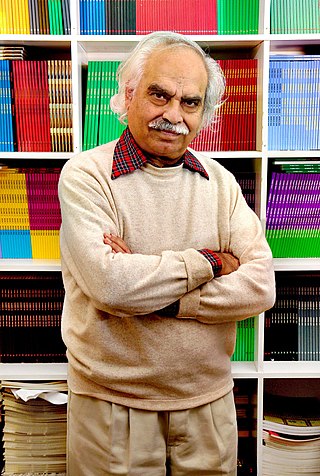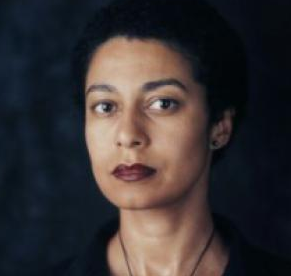Related Research Articles
Events from the year 1989 in art.
Into the Open, subtitled "New Paintings, Prints and Sculptures by Contemporary Black Artists", was an exhibition of art by black artists displayed at various venues in the United Kingdom in 1984.
Aubrey Williams was a Guyanese artist. He was best known for his large, oil-on-canvas paintings, which combine elements of abstract expressionism with forms, images and symbols inspired by the pre-Columbian art of indigenous peoples of the Americas.

Sir Richard Sheridan Patrick Michael Aloysius Franklin Bowling, known as Frank Bowling, is a British artist who was born in British Guiana. He is particularly renowned for his large-scale, abstract "Map" paintings, which relate to abstract expressionism, colour field painting and lyrical abstraction. Bowling has been described as "one of Britain’s greatest living abstract painters", as "one of the most distinguished black artists to emerge from post-war British art schools" and as a "modern master". British cultural critic and theorist Stuart Hall situates Bowling’s career within a first generation, or “wave” of post-war, Black-British art, one characterised by postwar politics and British decolonisation. He is the first black artist to be elected a member of the Royal Academy of Arts.

Rasheed Araeen is a Karachi-born, London-based conceptual artist, sculptor, painter, writer, and curator. He graduated in civil engineering from the NED University of Engineering and Technology in 1962, and has been working as a visual artist bridging life, art and activism since his arrival in London from Pakistan in 1964.
The BLK Art Group was the name chosen in 1982 by a group of five influential conceptual artists, painters, sculptors and installation artists based in the United Kingdom. Keith Piper, Marlene Smith, Eddie Chambers and Donald Rodney were initially based in the English Midlands.
Liverpool and the Black Atlantic was a season of citywide series of exhibitions and events initiated by Tate Liverpool exploring connections between cultures and continents.
Lubaina Himid is a British artist and curator. She is a professor of contemporary art at the University of Central Lancashire. Her art focuses on themes of cultural history and reclaiming identities.

Maud Sulter was a Scottish contemporary fine artist, photographer, writer, educator, feminist, cultural historian, and curator of Ghanaian heritage. She began her career as a writer and poet, becoming a visual artist not long afterwards. By the end of 1985 she had shown her artwork in three exhibitions and her first collection of poetry had been published. Sulter was known for her collaborations with other Black feminist scholars and activists, capturing the lives of Black people in Europe. She was a champion of the African-American sculptor Edmonia Lewis, and was fascinated by the Haitian-born French performer Jeanne Duval.
Sutapa Biswas is a British Indian conceptual artist, who works across a range of media including painting, drawing, film and time-based media.
Veronica Maudlyn Ryan is a Montserrat-born British sculptor. She moved to London with her parents when she was an infant and now lives between New York and Bristol. In December 2022, Ryan won the Turner Prize for her 'really poetic' work.
Claudette Elaine Johnson is a British visual artist. She is known for her large-scale drawings of Black women and her involvement with the BLK Art Group. She was described by Modern Art Oxford as "one of the most accomplished figurative artists working in Britain today".
Uzo Egonu was a Nigerian-born artist who settled in Britain in the 1940s, only once returning to his homeland for two days in the 1970s, although he remained concerned with African political struggles. According to Rasheed Araeen, Egonu was "perhaps the first person from Africa, Asia or the Caribbean to come to Britain after the War with the sole intention of becoming an artist." According to critic Molara Wood, "Egonu's work merged European and Igbo traditions but more significantly, placed Africa as the touchstone of modernism. In combining the visual languages of Western and African art, he helped redefine the boundaries of modernism, thereby challenging the European myth of the naïve, primitive African artist."
Five Black Women was an exhibition at the Africa Centre, London, featuring the work of British artists Sonia Boyce, Lubaina Himid, Claudette Johnson, Houria Niati and Veronica Ryan held in 1983. The exhibition was organised by Himid, the first of several "widely respected" exhibitions she organised featuring Black women artists.
Avinash Chandra was an Indian painter, who lived and worked in the United Kingdom.

Brenda Patricia Agard was a Black-British photographer, artist, poet and storyteller who was most active in the 1980s, when she participated in some of the first art exhibitions organized by Black-British artists in the United Kingdom. Agard's work focused on creating "affirming images centred on the resilience of the Black woman," according to art historian Eddie Chambers.
Joseph Adekunle Olubo, was an artist and book illustrator active in the 1980s. He participated in some of the first art exhibitions organized by Black British artists in the United Kingdom. Olubo was one of 22 artists included in the 1983 inaugural exhibition, Heart in Exile, at The Black-Art Gallery, an art space in London which worked with artists of African and Caribbean backgrounds.
Nina Edge is an English ceramicist, feminist and writer.
The Essential Black Art was an art exhibition held at the Chisenhale Gallery in 1988, curated by Rasheed Araeen. The exhibition contained the work of nine artists: Araeen, Zarina Bhimji, Sutapa Biswas, Sonia Boyce, Eddie Chambers, Alan de Souza, Mona Hatoum, Gavin Jantjes and Keith Piper. It provided a foretaste of Araeem's larger exhibition of the following year, The Other Story.
Amanda Bintu Holiday is a Sierra Leonean-British artist, filmmaker and poet.
References
- ↑ "The Other Story: Asian African and Caribbean Artists in Post-War Britain". aaa.org.hk. Retrieved 24 November 2018.
- ↑ "The Other Story: Afro-Asian Artists in Post-War Britain - imageroll • Afterall". www.afterall.org. Retrieved 24 November 2018.
- ↑ "FORMER WEST – The Other Story". www.formerwest.org. Retrieved 24 November 2018.
- ↑ "Collective Creativity". qtipoccollectivecreativity.tumblr.com. Retrieved 24 November 2018.
- 1 2 "Retelling 'The Other Story' – or What Now? - The Other Story: Afro-Asian Artists in Post-War Britain • Afterall". www.afterall.org. Retrieved 24 November 2018.
- ↑ "The Other Story: Afro-Asian Artists in Post-war Britain - Google Arts & Culture". Google Cultural Institute. Retrieved 24 November 2018.
- ↑ Araeen, Rasheed (1989). The Other Story: Afro-Asian artists in post-war Britain. Hayward Gallery, Wolverhampton Art Gallery and Museums, Manchester City Art Gallery. London: South Bank Centre. p. 7. ISBN 185332051X. OCLC 29388666.
- 1 2 3 4 5 "The Other Story and the Past Imperfect – Tate Papers". Tate. Retrieved 24 November 2018.
- ↑ "Notes from the Field: Navigating the Afterlife of The Other Story". aaa.org.hk. Retrieved 24 November 2018.
- ↑ Araeen (1989). The Other Story. p. 15. OCLC 29388666.
- ↑ Araeen (1989). The Other Story. p. 5. OCLC 29388666.
- ↑ "Silly Rhetoric of Ms Biswas". aaa.org.hk. Retrieved 24 November 2018.